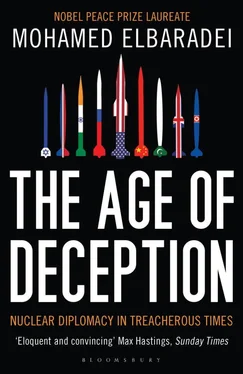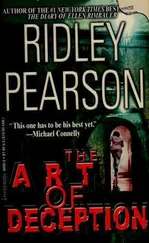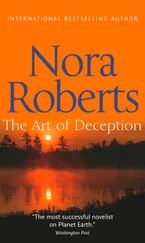Howard Fineman, “I Sniff Some Politics,” Newsweek , May 27, 2002.
Japan-DPRK Pyongyang Declaration, September 17, 2002.
KEDO was founded in 1995 by the United States, South Korea, and Japan, to implement the principal energy provisions of the Agreed Framework, including the construction of the two promised light water nuclear power reactors. Until the reactors were completed, North Korea was to be provided with five hundred thousand metric tons of heavy fuel oil annually. As I have noted, North Korea was already complaining of a lack of good faith on the part of the United States and KEDO, because of delays in the light water reactor construction. The suspension of fuel oil shipments was the proverbial last straw.
Since withdrawal from the NPT takes three months to go into effect, North Korea’s decision became official on April 10, 2003. Although the IAEA Board had referred the matter to the Security Council for action, the council did not issue a resolution on the matter; following its closed-door meeting on April 9, council president Adolfo Aguilar Zinser of Mexico merely told reporters that council members had “expressed their concern” and would continue to follow up on developments.
May 14, 2004. The discussion was moderated by Graham Allison, director of the Belfer Center for Science and International Affairs, John F. Kennedy School of Government, Harvard University.
“In Search of a North Korea Policy,” October 11, 2006.
“Solving the Korean Stalemate, One Step at a Time,” New York Times , October 11, 2006.
“Mutually Assured Disruption,” New York Times , October 10, 2006.
“U.S. Now Uncertain About North Korea Uranium Enrichment,” Agence France-Presse, March 1, 2007.
“North Korea Lifts Nuclear Veil,” CNN, February 26, 2008.
On October 18, 2006, during a lower house committee session, Foreign Minister Aso said, “It is one idea not to allow discussions or even to talk about [possessing nuclear arms] when a neighbor country is going to have them, but it is important to have various discussions.” The next day he was quoted as saying, “Japan is capable of producing nuclear weapons.” But he added, “We are not saying we have plans to possess nuclear weapons.”
David E. Sanger, “North Koreans Unveil New Plant for Nuclear Use,” New York Times , November 20, 2010.
David E. Sanger, “U.S. Concludes North Korea Has More Nuclear Sites,” New York Times, December 14, 2010.
Of course, the council also needs to be reconstituted to be representative of the twenty-first century. It is absurd that the P-5, the council’s permanent membership, does not include countries such as Brazil, India, and South Africa.
The NCRI is an Iranian opposition group based in Paris, self-styled as a coalition of democratic Iranian individuals and groups prepared to form a provisional government if the current regime were to be toppled. Both Iran and the United States have classified the NCRI as a terrorist organization, citing its ties to the Mujahedin-e Khalq, a religious leftist affiliate of NCRI with a history of violence. The NCRI has repeatedly made allegations about Iran’s clandestine nuclear program, some of which have been substantiated by subsequent IAEA investigation. Whether the NCRI was used by Western intelligence to disseminate information about Iran’s nuclear activities was a question I often pondered.
In each of these three cases, the nuclear program was developed before the country was a party to the NPT.
Given the size of the Natanz facility, it is likely that the Iranians were not intending to “hide” it per se. Their aim, I believe, was to delay its reporting as far as legally permissible under their safeguards agreement and to delay IAEA inspection until they had completed their construction and received all the needed knowledge and technology, which were being obtained through clandestine channels due to sanctions. I was later told they were worried that declaring the Natanz facilities would expose their supply network.
For a decade, the United States had tried its level best, making demarches around the world, to dissuade the Russians from supplying Iran with the Bushehr reactor. The argument was that if the Iranians were to acquire a power plant, they would have a pretext for also developing fuel cycle capabilities. But the United States was not successful.
Salehi would later succeed Aghazadeh as the head of AEOI and vice president of Iran, and was subsequently appointed foreign minister.
The Palace of Mirrors, one of the shah’s old palaces.
Uranium enrichment using atomic vapor laser isotope separation, or AVLIS, method.
Leaded glass windows or cameras give the operators an inside-the-chamber view of the work they are doing using the remote handling equipment.
Former head of the U.S. Senate Armed Services Committee and one of the foremost American experts on defense policy, as well as a staunch supporter of the IAEA.
NTI is a nonprofit organization that funds selected projects to reduce the threat of nuclear weapons proliferation.
Both my op-ed and Bush’s speech, at the National Defense University, reflected an emerging awareness of the clandestine nuclear supply network of A. Q. Khan and his cohorts. A fuller discussion appears in chapter 7.
The December 26 earthquake in southeastern Iran, the most devastating quake in Iranian history, killed more than twenty-five thousand people, with tens of thousands more injured and homeless.
Paul Reynolds, “The Politics of Earthquakes,” BBC News Online, December 30, 2003.
In my October 2003 article in the Economist , I had made clear my view that bringing fuel cycle facilities under multinational control was only one step in a process that would ultimately lead toward nuclear disarmament.
Unfortunately, the concept of an international summit went no further. I was told that John Bolton had opposed the idea and found a way to keep it from happening.
“IAEA Breaches Legal Commitments Towards Iran,” Tehran Times , February 19, 2004.
I had met Putin once before at the newly renovated Kremlin during the first year of his presidency. While the Iranian nuclear file was not on the table at that time, I found him to be thoroughly engaged on nuclear issues, and he subsequently spoke out in support of the Agency on several occasions to counter U.S. criticism.
Interview with Gavin Esler on “Iran’s Nuclear Capacity,” BBC Two Newsnight , August 26, 2004.
“Photos of Suspected Secret Iranian Nuclear Site Released,” Agence France-Presse, September 16, 2004. Even in its use of language, this AFP article is a good example of the media tendency to hype such issues. Parchin is described as “a large industrial complex hidden in a warren of valleys and crevices”; the access route is depicted as “snaking between barren hills.”
Читать дальше












